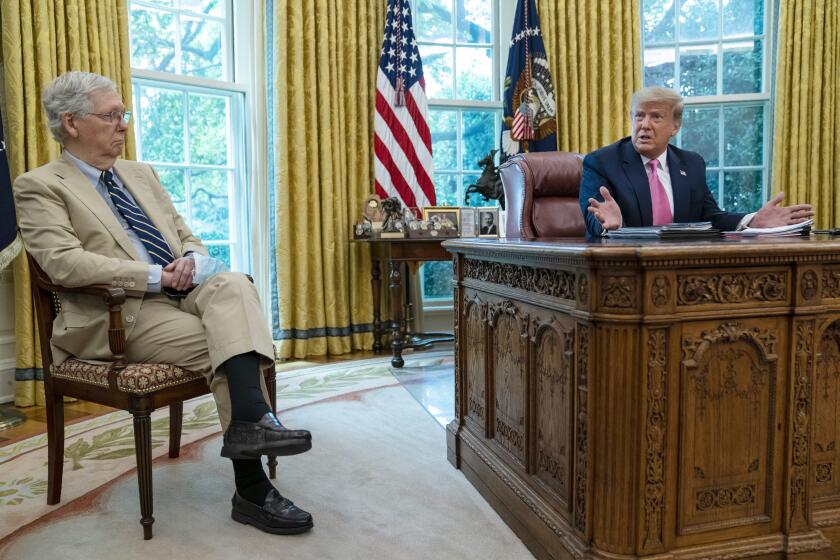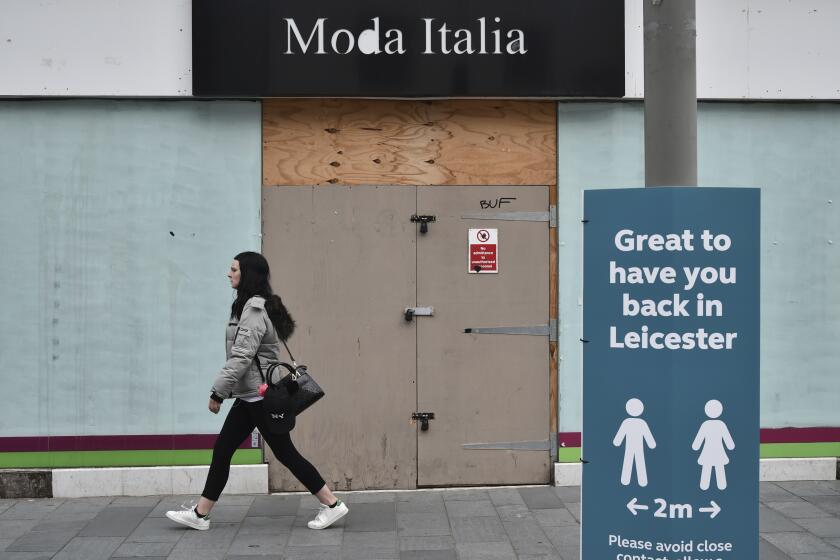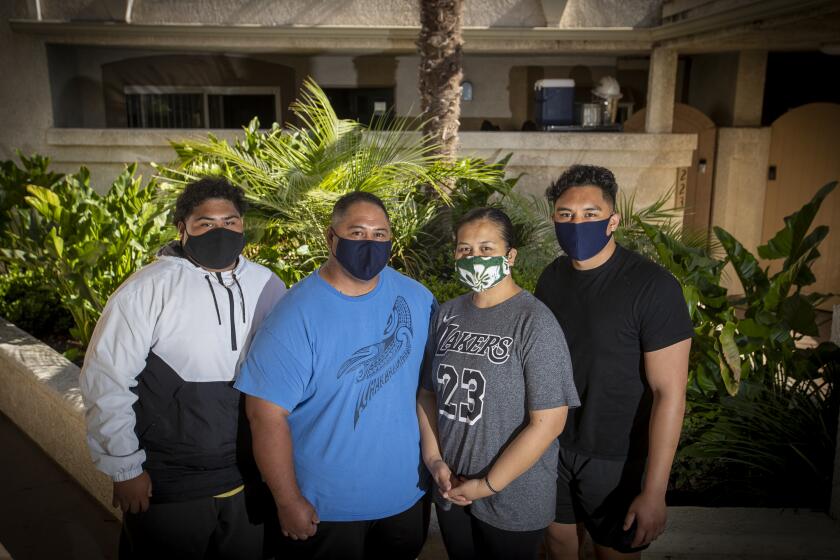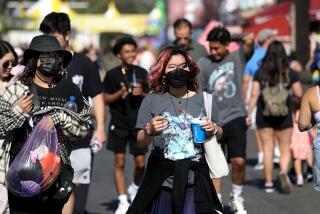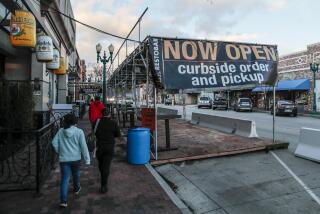L.A. may become the biggest U.S. city with a second stay-home order
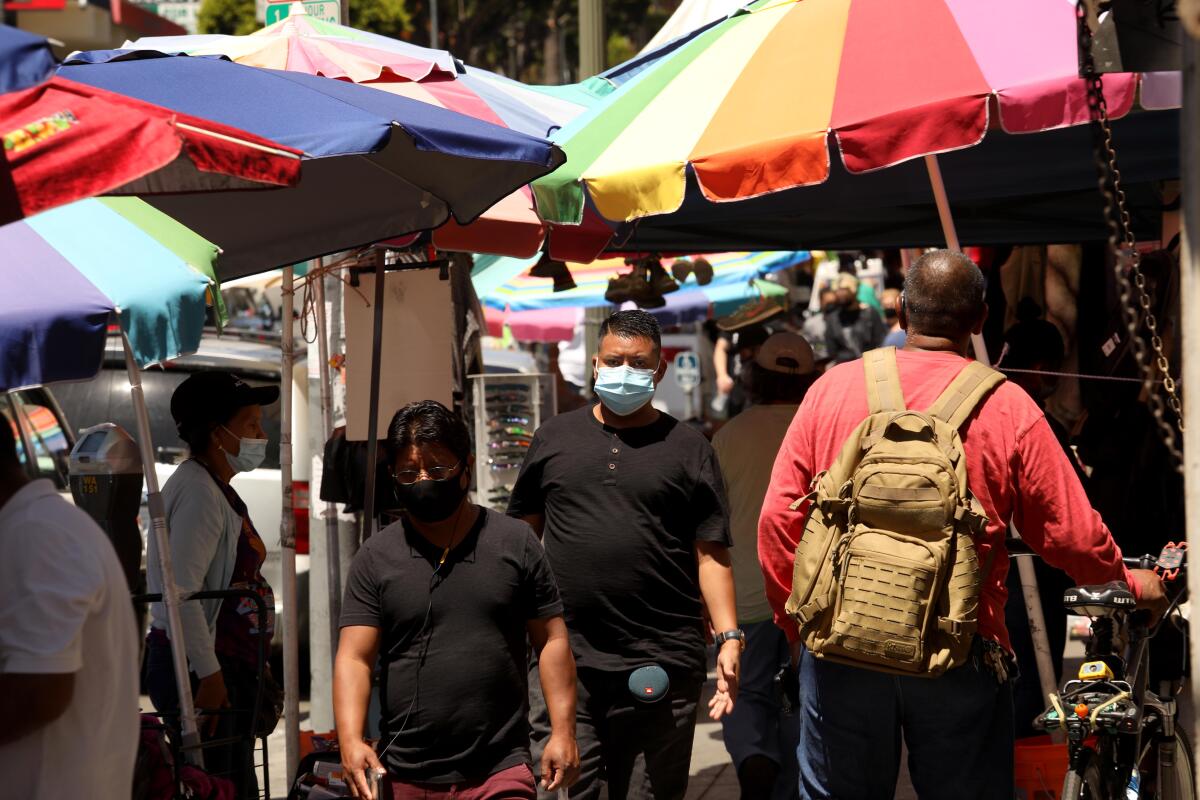
- Share via
Los Angeles was one of the first major cities in the nation to impose a stay-at-home order when the COVID-19 pandemic hit.
Now, L.A. may soon have the dubious distinction of being the biggest U.S. city to receive a second stay-at-home order, amid a surge of coronavirus cases and hospitalizations that so far shows few signs of slowing.
For two weeks, Mayor Eric Garcetti has warned that the city is close to returning to some type of stay-at-home order due to the new increase — which became clear in June after businesses began to rapidly reopen in May — but has held off.
On Sunday, he said a decision will probably come in the next week or two as officials determine whether restrictions imposed in late June and July — such as closing bars, indoor restaurant dining and shopping malls — slowed the rapid community spread of COVID-19.
Los Angeles had long been one of the hardest-hit parts of California, recording a disproportionate share of the total cases and fatalities.
But the new wave has also hit surrounding counties such as Orange, San Bernardino and Riverside. All of California is seeing rising cases, although some heavily populated areas have been hit relatively less hard so far, like the Bay Area, which has seen fewer than half as many new cases over the last two weeks than L.A. County on a per capita basis.
President Trump is acknowledging a “big flare-up” in COVID-19 cases, but divisions between the White House and Congress are threatening passage of a new federal aid package.
Some health experts said the situation makes another stay-at-home order for Los Angeles County a real possibility if the conditions don’t improve soon.
“I wish we weren’t in this situation, I really do,” said Dr. Kirsten Bibbins-Domingo, chair of UC San Francisco’s Department of Epidemiology and Biostatistics. “And again, I want to stress this is not punitive. We are in a situation where we did so well at the beginning of this pandemic. And I believe we could get back there ... but it means for a period of time, we have to do what it takes to make sure the virus has no place to go.”
Few, if any, big cities in the U.S. have reimposed a second stay at home order after reopening. But Leicester, England — which is known for its garment industry — was forced to do so after a severe outbreak among heavily nonwhite areas of the city, according to the medical journal Lancet.
Even a less strict version of the spring stay-at-home order would be a devastating blow to Los Angeles, where the coronavirus has battered the economy and the county’s unemployment rate hovered around 19.5% in June. Many cheered when state and local officials began reopening the economy in May and June, hoping that social distancing, masks and workplace safety rules would keep COVID-19 in check.
But it hasn’t worked out that way.
Some people went back to old habits, such as participating in summer social events, and it’s becoming increasingly clear some employers are not enforcing safety rules. Latino workers are getting sick at disproportionate levels, and officials believe many are becoming infected at work and bringing the virus home.
Stuart Waldman, president of the Valley Industry and Commerce Assn., watched with dismay as people ignored health guidance.
“The city reopened, but people’s behavior reverted to what they were doing before,” Waldman said. “Unfortunately, people jumped back in like the virus was gone.”
Another shutdown could leave businesses, already reeling from months of losses, at the breaking point.
“It’s very important for businesses to be able to plan, and if we keep opening and closing, that is not in the best interest of those businesses that are trying to stay open,” said Maria Salinas, president of the Los Angeles Area Chamber of Commerce.
On Monday, public health officials reported at least 3,128 new cases, pushing the cumulative total past 159,000.
The number of people hospitalized in L.A. County with confirmed coronavirus infections on Sunday was 2,218 — the second-worst tally so far in the pandemic, just below the record of 2,232 set on Saturday.
While the rest of England gingerly reopens, the city of Leicester has gone back into lockdown because of a troubling coronavirus infection rate.
More than 4,100 people in the county have died. Among California’s most populated counties, L.A. County has one of the worst per-capita rates of coronavirus-related deaths in the last two weeks, reporting 6 deaths per 100,000 residents. Orange and Riverside counties reported about 4 deaths per 100,000 residents; San Diego and San Bernardino counties, 2.8; Ventura County, 1.2; and San Francisco, 0.2.
Despite the increase, L.A. County is still in good shape when it comes to available hospital beds. Hospitalizations are rising but not as dramatically as seen in some weeks.
Officials are hoping to see cases begin to flatten in the coming week, accounting for new restrictions implemented just before the July Fourth holiday and beyond. But no one is sure if that will materialize.
Garcetti and other leaders have suggested that changes in behavior can still save the day.
“It’s not just about what’s open and what’s closed. Much of this is also about our actions,” Garcetti said at a news briefing Friday. “You could close plenty more, but if young people were still congregating outside of their household in large numbers, we would still see spread.”
Barbara Ferrer, the L.A. County public health director, said Monday that there are three main reasons for why people are getting infected: gatherings, workplaces and people not taking the disease seriously.
Pacific Islanders are seeing higher rates of infection from the coronavirus than any other racial or ethnic group in Los Angeles County.
In particular, the spread at work happens at places “where people are very close together for long periods of time, and where the business owners and operators haven’t yet fully implemented the directives to try to keep people as separated from each other as possible,” Ferrer said.
Just months ago, local leaders were thanking Angelenos for staying at home and following social distancing guidelines. Then, some businesses were allowed to reopen in May. But as cases ticked up again, many businesses in counties across the state were again ordered closed under an order issued by Gov. Gavin Newsom.
Garcetti was asked at the news briefing what would need to happen for him to support another stay-at-home order. Garcetti said he supported Newsom’s recent decision to shut down some businesses and that he is waiting to see the effects of those moves before acting.
“If you just go with this moment, you’re basically making decisions based on where we were two to three weeks ago,” Garcetti said.
Garcetti also said his goal was to get L.A. off the state’s watchlist. His spokesman, Alex Comisar, said that requires reducing disease transmission, lowering hospitalization and ensuring adequate hospital capacity.
Meanwhile, Garcetti told CNN on Sunday that “mayors often have no control what opens up and doesn’t — that’s either at a state or county level. And I do agree that those things happened too quickly.”
Despite his comments, local leaders like Garcetti are permitted to issue closure and stay-at-home restrictions that are stricter than those issued by the county or state, just not rules that are more lenient.
Garcetti in fact did so on March 19, issuing a stay-at-home order for the city of Los Angeles, while county officials stopped short of such an order. The distinction did not receive much attention at the time, however, since Newsom on the same day also issued a statewide stay-at-home order.
County Supervisor Kathryn Barger, when asked about Garcetti’s comments on CNN, suggested in a statement that the mayor was not left out of conversations about reopening the region.
“All of the decisions regarding the initial Safer at Home orders, the gradual reopening of businesses and activities, and the subsequent closures have been done in collaboration with local leaders and health officials, and guided by public health data,” Barger said.
At a news briefing Monday, Barger defended the decision to open up L.A. County’s economy, but added that the county needs to do a better job of getting out its message that reopening up society “doesn’t mean people can let their guard down.”
“And I believe that is what happened … you had Memorial Day as well as protests that were taking place. People were not practicing social distancing and, in fact, in some cases, were not wearing a mask,” Barger said.
Times staff writer Jaclyn Cosgrove contributed to this report.
More to Read
Sign up for Essential California
The most important California stories and recommendations in your inbox every morning.
You may occasionally receive promotional content from the Los Angeles Times.
